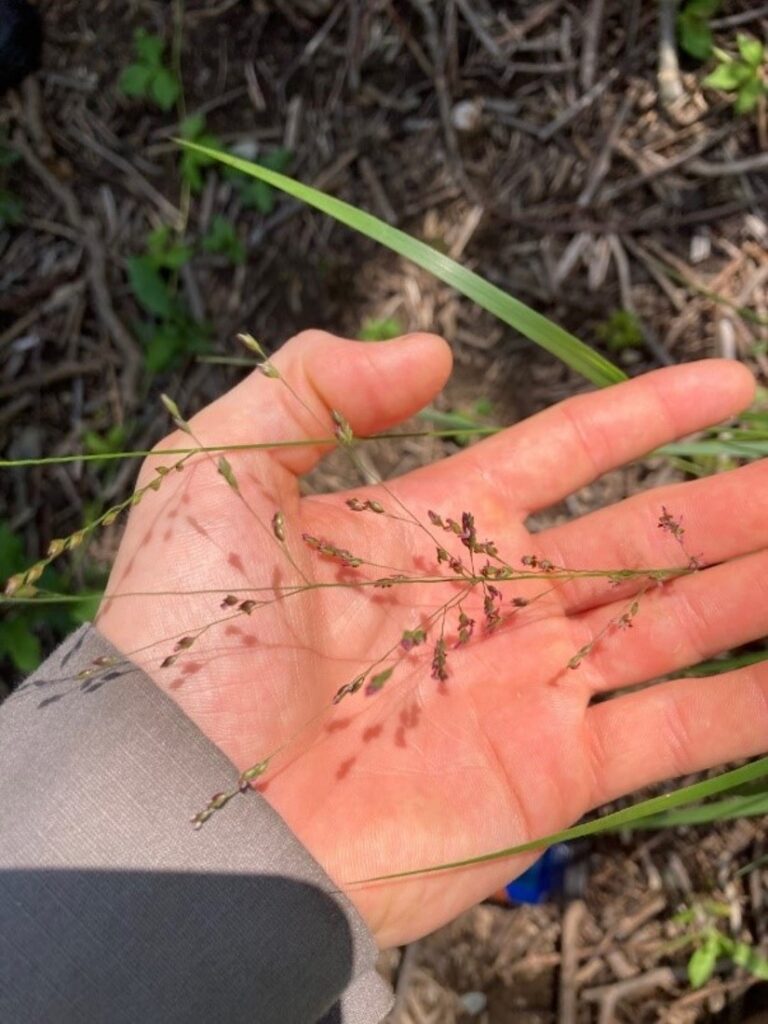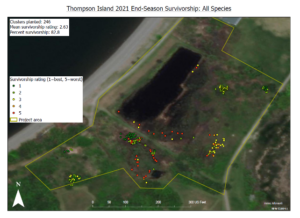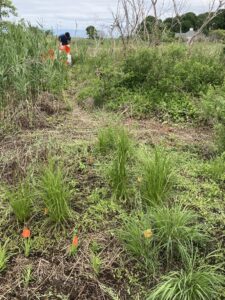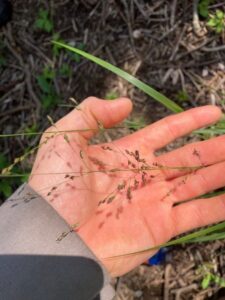2021 Planting Year in Review

Original pieces written by John Mark Lampley and Laura Yates. Compiled and edited by Rachel Vincent
Plantings of native northeastern herbaceous plants, shrubs, and trees have been a part of the Natural Resource Partnerships team’s long-term integrated management strategy for four years, the first planting season having taken place on Grape Island in 2018. Plantings have been conducted in rare freshwater wetland ecosystems and their adjacent uplands on two harbor islands—Grape and Thompson Islands—with the goal of restoring native biodiversity, enhancing cultural landscapes, and combating the spread of non-native invasive vegetation.
To date, nearly 7,000 individual plants have been planted. This year 1,735 individual specimens from 14 species were planted on Grape and Thompson Islands, with 1,563 individuals surviving all the way to the end of the field season in November. In between plantings, staff and volunteers continued working hard to clear invasive plants from the ground. This year, the following native plants put down roots on Grape and Thompson:
- Broomsedge bluestem (Andropogon virginicus)
- Blue-eyed grass (Sisyrinchium angustifolium)
- Wavy-hair grass (Deschampsia flexuosa)
- Common woolsedge (Scirpus cyperinus)
- Little bluestem (Schizachyrium scoparium)
- Canada goldenrod (Solidago altissima)
- Sallow Sedge (Cared lurida)
- Panic switchgrass (Panicum virgatum)
- Grass-leaved goldenrod (Euthamia graminifolia)
- Blue vervain (Verbena hastata)
- Saltmarsh rush (Juncus gerardii)
- Swamp milkweed (Asclepias incarnata)
- Spotted joe-pye weed (Eutrochium maculatum)
- Highbush blueberry (Vaccinium corymbosum)
To track the survivorship of individual clusters of plants, the team marked sets of plants with pin flags during planting, then collected points using the ArcGIS Collector application and a Geode GPS receiver. Using these data points and GPS equipment, the plant clusters were revisited in August for Grape Island, and November for Thompson Island to track success throughout the season. Survivorship rating was based on several factors: visible growth, first season flowering, and seed production. Since the highbush blueberry plants were planted in late September, their survivorship was not analyzed this season.
As a note, one year after a significant drought in the summer of 2020, 2021 was an unusually high rainfall year for Greater Boston. Naturally, this shaped the progression of all our plantings. While staff relished in the reprieve from carrying buckets of water all over the planting sites, and some new plantings thrived on the extra water, some of the wetland edge species may have had their “feet” too wet for great success.

Thompson Island Survivorship Inventory. Map compiled and organized by Ben Curell using ArcGIS Collector and Geode GPS receiver
The above map shows the location of each individual cluster of plantings from the 2021 field season. The key on the left shows the yellow border of the project area and color codes each planting site according to plant condition at the time of data collection in late October and early November. As noted above, some wetland species did better than others.
Some of the greatest successes from planting this year were with upland species. In particular, all 4 of the grass species planted this season thrived. With 3 individual exceptions, every planting of Broomsedge Bluestem, Little Bluestem, Wavy-hair Grass, and Panic Switchgrass made it through to their first fall—and most flowered and fruited in their first year. Notably, Common Woolsedge (Scirpus cyperinus) has proven itself probably the single-most successful species for direct transplant in the field. Both in last season’s drought and this year’s abundant rain each specimen we planted not only survived, but in most cases doubled or tripled in size, and produced abundant flowers and seeds.
Planting truly takes a village! Special thanks to our partners at the Massachusetts Department of Conservation and Recreation (DCR), Thompson Island Outward Bound, and UMass Boston Marine Operations for their help in getting plants, staff, and supplies out to the islands! Additional thanks to our partners at the Native Plant Trust for germinating the plantings from seeds (many of which were collected from the islands), caring for them until they were ready to be planted, and even making the trip out to the islands to plant. And a huge thank you to the volunteers and staff from other teams who were able to join the crew to get the plants in the ground and cared for.

NPS Photo. In the foreground, small orange pin flags are visible surrounded by clusters of freshly planted grasses. In the background, an individual is holding an orange bucket upside down as they water another set of plantings.

NPS Photo. Spikelet of Panic switchgrass (Panicum virgatum) at Thompson Island.